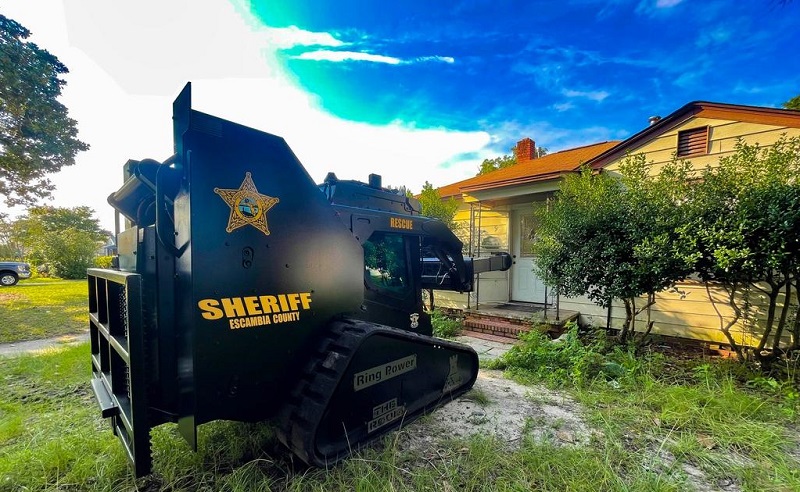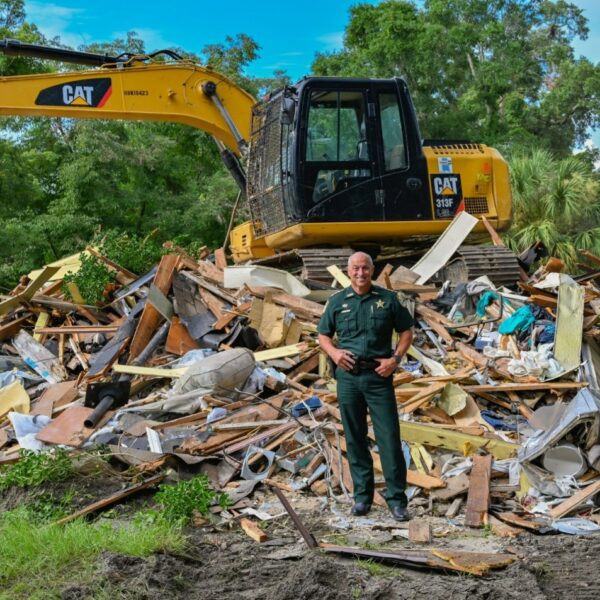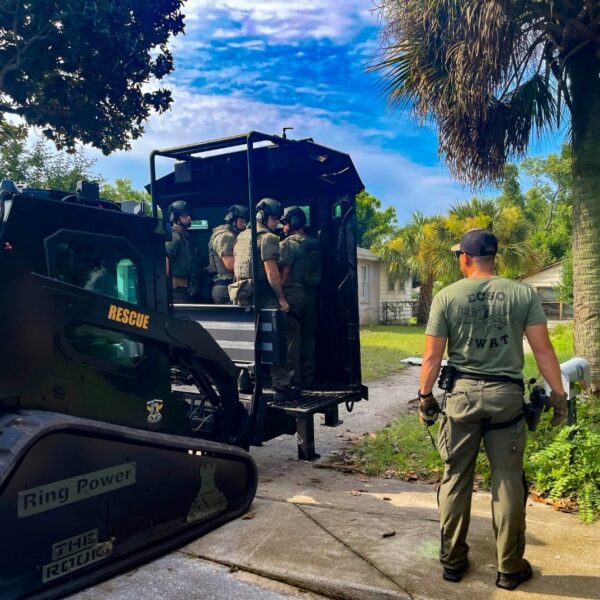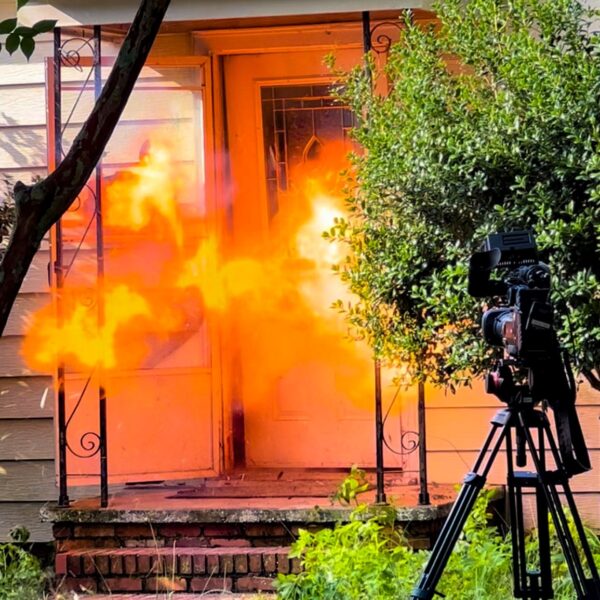
It is nice for a community to be free of criminal dens operating in their midst. What isn’t nice is the inherent dangers to law enforcement striking a final blow, at great risk to themselves, while sanitizing a city of a historical scourge. Deputies did it anyway, and residents are elated to be rid of the “troubled house,” otherwise known to cops as a “drug house.”
In the panhandle of Florida, the Escambia County Sheriff’s Office (ECSO) carefully coordinated and literally leveled a long-time troubling house in which criminal enterprising had been transpiring, draining police and other city resources.
The Escambia County Sheriff’s Office issued a press release: “The ownership/residence at 9 Cousineau Road has been an issue for the Navy Point residents and a drain on law enforcement and code enforcement for many years.
“Since 2019, the Escambia County Sheriff’s Office has answered over 20 calls for service at this location, and there have been numerous complaints from neighbors. Additionally, the Escambia County Code Enforcement has followed up with complaints for unsafe structure, broken windows, solid waste, trash, and debris,” declaring the trouble spot “a constant and continuing nuisance.”
Not anymore.
Residents had enough! Deputies put an end to it all. Demolition machinery followed.

(Photo courtesy of the Escambia County Sheriff’s Office.)
The mound of rubble that used to be a drug den where malfeasants dwelled and did much more than dabble in illegal activities…is now in Dumpsters.
“The individuals who frequent this location have extensive criminal backgrounds. There have been arrests at this address for criminals with charges of active battery, violation of probation, kidnapping, domestic violence, manufacture of drugs, possession of a controlled substance, controlled substance without a prescription, possession of cocaine, and weapons charges,” a sheriff’s office post-incident report explained.
Not anymore.
Police Partnering with Code Enforcement
Coordination between the sheriff’s office and county code enforcement put this drug den to rest.
Per the Escambia County Environmental Code Enforcement, they investigate code, ordinance, state statute, and administrative code violations committed in Escambia County. The Escambia County Environmental Enforcement Division operates under Chapter 162 of the Florida Statutes and Chapter 30 of the Escambia County Code of Ordinances.”
The sheriff’s deputies dealt with the criminal elements (and safety for all on-scene) while Code Enforcement handled the administrative responsibilities, ultimately pooling resources to shut down a known drug haven.
After years of criminal activities and county code violations ensued, a “Final Notice of Demolition” order was endorsed by the courts and served. “Final” also means previous warnings went unheeded after due process was exhausted. (Deep-rooted hardcore criminals don’t generally give a hoot.)
Incidentally, only once in my police career had I witnessed a similar circumstance whereby the drug house was raided and subsequently demolished. The knock-down order stemmed from the property being deemed “unsafe and unlivable” due to “interior decay” and significant structural deterioration (implying a redux).
The Final Notice of Demolition contained this passage: “These measures include, but are not limited to demolishing your structure(s), and legally disposing of all contributing conditions, and towing of described vehicles if applicable. The reasonable cost of such will be assessed against you and will constitute a lien on the property.”
Before the sheriff’s office and code enforcement descended upon this crime hotspot for the final straw, it festered as a definite blight and threat that all neighbors and passersby tolerated.
Not anymore.
Enforcing Local Code Compliance
Not all violations in a city or town are criminal; many are in the realm of administrative code otherwise listed among a sovereign government’s ordinances (local laws the city council or county commission sets). These generally mirror state statutes, except some may have a homegrown ideal for which ordinances are written to curb certain no-nos.
As a municipal cop in field training to cut my teeth and put to use what the police academy taught me, I quickly found our city ordinance book had some obscure but useable nuggets to employ in the context of contacting people not exactly practicing safety features.
One such occasion, while driving a police cruiser, with my field training officer (FTO) in the passenger seat, involved a male walking in the street, along the curb (not crossing), and against the direction of vehicular travel.
My FTO shared that he had a history of contact with the man, including having arrested him several times in recent years.
My FTO asked me, “So, do you think you have probable cause to stop that guy right now?”
I smirked, took a few more glances, and plead ignorance. The FTO nodded his head and hinted, “What about an ordinance violation?” Eureka, a clue!
Considering that we were slowly mobile as the man walked in the street, my FTO had me stop the car and then instructed me to look up a particular ordinance titled “All pedestrians must walk on the sidewalk when one is provided.” Pretty self-explanatory; not much language after the title.
There was a perfectly fine concrete sidewalk. With that probable cause established, we made contact with the guy.
Turns out he had an arrest warrant for his arrest and some dope in both front pockets of his pants. If not for the local ordinance stipulation, the guy would likely have remained a fugitive wandering around with narcotics in his possession.
If not for my FTO cueing me in on the availability of local legislation, providing me with probable cause to contact the individual and educate him on why he was being stopped and obtain/run his state ID card, I’d be none the wiser.
That was one of the first scenarios I taught to my trainees when I made the grade as an FTO. Each rookie looked at me as if I were teasing…until I whipped out the chunky binder of local ordinances and pointed out the truth in black and white. Yes, there’s much more than the chunky statute book of criminal codes.
Code enforcement officers, generally civilians, many of whom are retired law enforcement officers, conduct follow-throughs on complaints made by residents or merchants against properties in the jurisdiction.
As the Escambia County authorities mentioned above about city code stipulations, typical violations of local ordinances entail unsightly and/or unsafe conditions (heaped debris which may contain sharp items and/or unsanitary hulks such as toilet bowls in plain view). Not very neighborly.
Overall, a one-fell swoop flattened this criminal cancer and excised it from the street…
But not before the ECSO SWAT team got in one last run-through, right before the demolition.

(Photo courtesy of the Escambia County Sheriff’s Office.)
One day prior, folks on the street got courtesy advisement that the SWAT team would be on scene at the soon-to-be-defunct house of horrors, conducting training and deploying specialized equipment fashioned for officer safety. As well, in-proximity neighbors were given a heads-up that flash bangs would be used.
Flash-bangs are non-lethal explosive canisters used by law enforcement officers to effectively stun and disorient people, namely sought-after criminals holed up in dwellings.

(Photo courtesy of the Escambia County Sheriff’s Office.)
Also known as stun grenades, flash bangs make a loud noise accompanied by a bright flash of light when detonated. They are designed to shock the system of unsuspecting criminals, so that cops can swiftly follow through with securing and/or arresting occupants while ensuring officer safety and evidence preservation. Ever heard of “getting the drop” on someone?
SWAT Magazine provided a neat historical view of flash-bangs, aka “distraction devices.”
As Escambia County Sheriff Chip W. Simmons said, “If you are engaged in criminal activity and are a continuing nuisance in a neighborhood, you could/will lose your right to live there. Our neighborhoods deserve better and should not have to tolerate continuing illegal activity. This neighborhood became a better place today.”
Another one down…